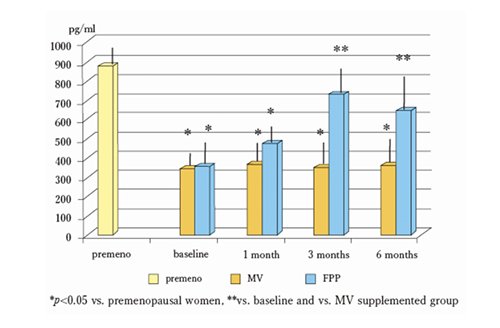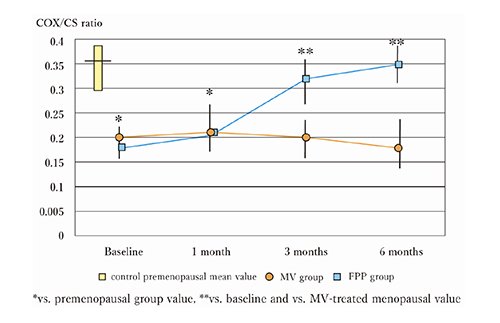Research
MITOCHONDRIAL AND REDOX DYSFUNCTION IN POST-MENOPAUSE AS RISK FACTOR OF NEURODEGENERATIVE DISEASE: A PILOT STUDY TESTING THE ROLE OF A VALIDATED JAPANESE FUNCTIONAL FOOD
J Biol Regul Homeost Agents. Jan-Feb 2020;34(1):111-121.
During the menopause women may experience increased oxidative stress and decreased antioxidant capacity and, together with the decline of neurosteroids, this represents a risk factor for Alzheimer's disease.
The aim of the present study was to test a functional food (FPP-ORI, Osato Research Institute, Gifu, Japan) on redox and mitochondrial efficiency in post-menopausal women.
The study population consisting of 69 untreated post-menopausal women were given supplements as follows: Group A was given a multivitamin※1 (MV) 1capsule, 2 times a day, and group B was given FPP 4.5 g 2 times a day. Group C consisted of 23 fertile premenopausal women as the control group. The tests carried out on entry, and at 1, 3 and 6 months were erythrocyte redox parameters, plasma oxidated proteins, brain-derived neurotrophic factor (BDNF) and peripheral blood mononuclear cell (PBMC) mitochondria cytochrome c oxidase Vmax activity.
Table1 shows the time course of erythrocyte level of oxidative stress parameters in post-menopausal women due to intake of MV and FPP. Menopausal women showed an increased malondialdehyde (MDA) (p<0.05 vs control) which was normalized by both treatments (p<0.05), but MV failed to do so in the "BMI≥26" subgroup (p<0.05). All other redox enzymes and BDNF were significantly lower in menopausal women and they responded only to FPP (p<0.05) (Table1, Fig.1). Carbonyl protein level was higher in "BMI≥26" subgroup (p<0.05) and reduced only by FPP (p<0.05). The PBMC cyclooxygenase to citrate synthase activity was reduced (<40%) in the menopausal group (p<0.01) and only FPP caused a significant restoration (p<0.05) (Fig.2).
Although preliminary, these data confirm the redox and mitochondrial dysfunction occurring in post-menopause and responsive to FPP but very poorly to high dosage antioxidants. This may lead to potential preventive opportunities in menopause-associated neurodegenerative disease.
※1:MV composition(1 capsule):vitamin E 200 IU, resveratrol 250mg, coenzyme CoQ10 50mg, pomegranate 100mg, alpha-lipoic acid 100mg, selenium 80mcg
Table1:Time-course erythrocyte level of oxidative stress parameters in post-menopausal women:Effect of MV and FPP


Fig.1:Plasma BDNF in premenopause women and women under MV or FPP supplementation.

Fig.2:Time-course measurement of COX / CS ratio in PBMC adjusted by age. COX:cyclooxygenase;CS:citrate synthase
